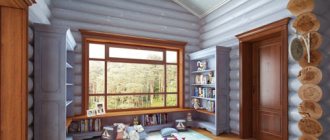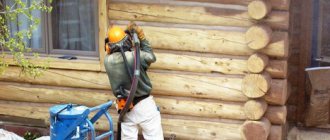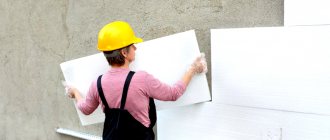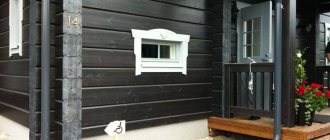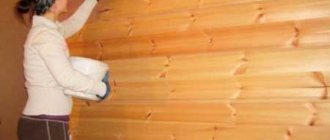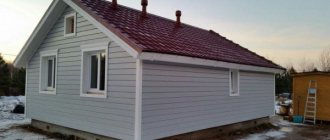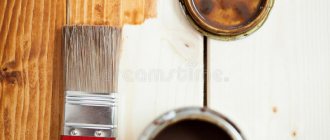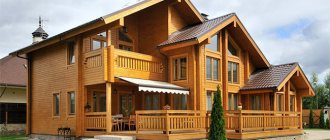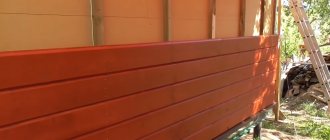The modern market offers a wide selection of different building materials, but wood is still one of the most in demand. It is difficult to imagine a village in which there would not be a house made of timber. Every owner, having built or purchased a similar property, once asks the question: how to paint the inside of a wooden house?
This is necessary to create the foundation of the building's interior and prevent pests from entering. How to paint a wooden house? Next, we will consider the options for various coatings with which you can paint your house.
Why do you need to paint?
Many owners do not paint the walls of their house. Logs look quite aesthetically pleasing, giving the premises a colorful look, but special processing of wooden structures is still necessary. This is done for a number of reasons:
- The use of specialized mixtures will help reduce the risk of fire.
- Preventing the process of rotting. By covering the wood with special solutions, you can preserve it in its original form for a long time.
- The paint coating prevents the appearance of various mechanical defects.
- Coloring will hide minor imperfections in the material.
- Applying a paint coating will prevent the appearance of various wood beetles and parasites in the wood.
Wood preservatives
Painting wooden walls is a very difficult task. Before starting work, you should correlate your desires regarding the appearance of your home with the above-mentioned functions of the paintwork. To do this, you need to know the entire list of materials and tools used in this work.
Before you begin applying the decorative coating, you should prepare the work surface for painting. This procedure is divided into three main operations: mechanical cleaning, grinding, and applying protective materials.
There are many different compounds designed to prevent harmful effects on wood. Conventional antiseptic solutions are created to resist fungi and mold that have arisen on wood, and also to prevent their subsequent occurrence. These substances themselves are divided into various aspects.
There are two types of antiseptics - impregnation and coating. The former are deeply absorbed into the beams, protecting them from pests and making them more resistant to external factors. The latter create a special layer on the wooden surface that protects against moisture.
Different types of antiseptics
Depending on what the solution is based on, the following types are distinguished:
- Water-soluble antiseptics are absolutely harmless substances, therefore, ideal for application to interior walls. As a rule, they are used together with water-based paints. A noticeable disadvantage of these substances is the decrease in their protective properties after a certain time.
- Antiseptics using organic compounds have good protective properties, but their use for interior work is contraindicated due to increased toxicity.
- Oil solutions are recommended for treating external walls, especially if you live in an area with bad weather conditions.
- Mixed solutions are a combination of oil and high-carbon elements. They are great for any surface. They are very resistant to all external factors. In fact, these are universal tools. If you have a question about what to coat the surface with before painting, then this is the best choice, although not the cheapest.
Biomoisture protective antiseptics are used to protect wood from harmful formations and parasites. This type of antiseptics allows you to create a kind of protection on the wood surface, while at the same time being a cosmetic element. Therefore, this substance is considered multi-purpose. These antiseptic properties not only save the owner money, but also reduce painting time.
There is another group of protective agents, the so-called fire retardants. They are used to increase the resistance of wood to fire, in other words, material treated with this substance can withstand the action of an open flame for a long time without igniting.
Primers for wood
Wood primer is considered a good means of protection. These compounds protect the material from destruction and, among other things, help the paint penetrate the wood better. Wood bleaching agents are used to remove all kinds of flaws from it - darkening, stains or black highlights.
Together with the whitening of these defects, these substances perform a protective function. They can be one-component or two-component. Two-component products are sold separately (each component separately). Their connection is carried out before starting work.
Preparatory stages
Before applying painting materials to the frame, it should be thoroughly processed. First you need to remove all contaminants from the surface. A brush with soft bristles, a washing vacuum cleaner or an ordinary garden hose are suitable for this. Just be careful not to water the logs abundantly; the tree may become saturated with moisture and will take several weeks to dry.
Grinding
Sanding of the log house cannot be performed immediately after completion of construction work. Wood with high humidity is poorly processed, and any further coating will look unsightly on a poorly polished surface. Therefore, the house must stand for at least a month. It is also recommended to carry out such work at an ambient temperature of no lower than 10–15 °C and no higher than 30 °C. For internal surfaces this circumstance is less critical than for external ones.
Before starting grinding, the log house should be checked for leaks. The result is to caulk possible cracks and gaps left after construction. If this stage is not necessary for houses made of laminated veneer lumber, then log buildings (especially in the crown joints) may have some leaks that must be carefully sealed using acrylic or silicone-based sealants.
Since wood of normal humidity is sanded quite easily, you should not use a massive tool. The optimal power of an angle grinder is 800–1000 W. In this case, the size of the grinding disc must be consistent with the diameter of the rounded log. Preference is given to machines that allow you to adjust the speed of the grinding disc.
When sanding with your own hands, work begins with the back walls and the most even areas: this makes it easier to get used to the tool. When calculating the required time, it is worth remembering that it takes about 5–8 minutes to process one linear meter.
Then you should sand the surfaces of the ends inside and outside the house with sandpaper. This processing stage is quite labor-intensive. The smoother the surface, the easier and faster the protective impregnation of the wood will apply. A grinder with an emery wheel will help speed up the grinding process. To sand wood, you should use two types of sandpaper: coarse and fine grit.
Grinding is performed using circular movements of the disc over all elements of the frame, starting from the top rows. It is not recommended to treat all walls and areas at once - the sanded surface quickly becomes weathered, and therefore requires immediate impregnation with an antiseptic. Therefore, the processing process should be divided into a number of successive stages.
In hard-to-reach places, grinding is done manually - using a chisel.
Antiseptic impregnation
Logs require immediate surface coating with anti-rot compounds, which should be done immediately after sanding. For this purpose the following can be used:
- Bioprotective compounds that protect wood from the harmful effects of ultraviolet radiation and also increase the moisture resistance of wood.
- Fire retardants that provide adequate fire protection for your home. They are carcinogenic substances, so special precautions are required when handling them!
- Combined preparations that combine both fire-resistant and moisture-preserving impregnations. For example, acrylates are substances that, when painting a surface, simultaneously increase its resistance to adverse external factors.
- Antiseptic compounds. Antiseptics for internal and external use are produced separately.
- Compositions that destroy tree pests. For this purpose, fumigation (fumigation with special generators) is used after grinding. To do this, it is better to invite specialists. Also, to combat wood borers, they are treated with ultrasonic fields. In the interior of log houses, you can use a regular microwave oven with the door open, but you should be careful - it is dangerous.
Fire-, bio- and moisture-resistant impregnations are applied in 2 layers and left for 10–14 days for complete absorption and distribution throughout the wood.
In order to save money, you can use the “old-fashioned” secrets of processing a house made of logs. Wax and turpentine have long been used in equal proportions to protect against rodents. The inside of the log house can be treated with starch or laundry soap.
Machine oil can be used as a water-repellent layer on the outside.
General recommendations
How to paint a wooden house from the inside? Every homeowner has asked this question at least once in their life. Painting a log house is not an easy task. Many owners, doing this themselves, skip the preparatory stage and immediately proceed to painting.
Because of this error, various troubles with painted surfaces are possible, for example, wood rotting and the appearance of parasites in it. You need to paint the wood according to the above description. Therefore, painting timber and timber houses will take a lot of time and effort.
Paint for the interior decoration of a wooden house must be environmentally friendly, dry quickly and have no odor. The decorative finishing of a room, as well as its design, directly depends on the correct choice of this material. When choosing paint, carefully study the labels and consult with store clerks.
Painting tips (1 video)
Different types of paints and varnishes (31 photos)
How to coat a log house after sanding
Question:
Good afternoon, Semenych! Please tell me, in the spring of 2018, a log bathhouse was installed from a winter Siberian forest (diameter 36-48), the lower three crowns are made of larch, the top is pine. The roof and ceiling were done almost immediately after the frame was built. Now we sandblast it.
The question is what to cover after sanding (primer, bioprotection, fire protection), in what order and in how many layers. We want to coat the outside with matte or semi-matte varnish. Which products are better - there are many manufacturers, and prices vary. Please advise.
Best regards, Elvira, Irkutsk.
Answer:
Hello, Elvira from Irkutsk!
In our practice, we most often cover the outer surfaces of log houses with belinka, tecurilla, and penotex.
True, sandblasting is far from the best option. We prefer to grind with conventional angle grinders; they leave less abrasive on the surface of the logs.
However, if after any type of sanding you walk over the logs with brooms, mops or a vacuum cleaner, there will be much less of this abrasive.
Builders do not have a unanimous opinion regarding the order of operations for coating wood with specific compositions.
Some first treat with antiseptics, which include both fire and bio protection, then apply a primer, and only then paint and coat with colorless varnish. Others do not use this order.
There are now a lot of different compounds on the market, I wouldn’t like to advertise them. In each case, you should carefully read the instructions on their labels. In this case, the most important thing is that all subsequent compositions are compatible. Because sometimes this is not the case, and after a year or two, or even a shorter time, the layers begin to separate from each other, crystallization of salts, their peeling, cracking, etc.
As a rule, brands from more well-known manufacturers, preferably imported rather than home-grown ones, have higher quality and longer-lasting characteristics. Although sometimes I had to run into expensive counterfeits of domestic “Kulibin” ones.
As they say, there are no comrades according to taste and color. But choosing colors and shades of dyes is also a difficult decision.
No matter how high-quality the dye is, over time (when after a year or two, when after five, or even ten years) it can still change its color tone. Atmospheric environment - rain, fog, dew, snow, etc. doing their job.
Most often, darker colors (like rosewood) are less susceptible to changes over time compared to lighter colors (pine or Oregon).
But not everyone likes dark colors, too gloomy, lighter ones are much more pleasant.
When you paint it in a light tone, it can darken very quickly and it happens that you can’t look at the logs of such a log without tears.
Just for fun, walk around and look at the wooden houses with different colors. I'm sure you'll notice the differences right away. And only then make a decision.
Varnish finishes are generally the right choice because the varnish fills the pores left after painting and the wood is less affected by the atmosphere.
So read everything I have said and take action. I understand that I’m not giving you definitive recommendations, but what you read shouldn’t make things worse.
In any case - good luck!
The method of applying the compositions is also important. The use of compressor devices for spraying them is productive, but the traditional old method of rubbing in with brushes, although a slower process, is of higher quality.
Construction in Moscow and Moscow region
We work with a guarantee! Wide range of construction services. Foundation, walls, ceilings, roofing, turnkey! +7 (905) 797-20-34
luxurykomfort.ru
Other questions on the topic of log houses:
- All about log houses
- Replacing logs in log houses
- About caulking log houses
Replacing logs in log houses
- Cost of replacing the top rims of a log house
- Replacing a cut-off wall with foam blocks
- Replace half a wall in a log house
- Replacing a rotten wall of a timber house
- Replacement of lower crowns and cracks in logs
- Replacing the lower logs of an already sheathed house
- Rotten places in logs
- Vertical log house made of round timber
- What to do with rotten logs from a log house
- Rotten crowns in the middle of the wall
- Replacing a log frame with a brick or block
- Replacing the lower crowns of a log house
- Replacing rotten crowns with bricks
- How to strengthen a corner in a log house
- When you need a fifth wall in a log house
- Vibrations in the log house
- Remove the three lower crowns of a log house
- Replacing a wall in a log house
- Replacing the lower crown with brick or foam blocks
- Joining logs of different diameters
- Replace the corner of a log frame with sleepers
- Replacing the lower crowns of a log house with a concrete wall
- Rotten log in a log house
- Restoration and cladding of a timber frame
- Reconstruction of an old log house
- Replacing a rotten corner of a house
- Repair of rotten beams in a log house
- Replacing the lower crowns of a log house with blocks
- Replacing rotten logs of a log house
- Replacement of the lower crown of the house
- Replacement of a main wall made of timber
- Transfer of logs in height in a log house
- Alignment and replacement of the lower crown of the log house
- Replacing rotten logs under the window with blocks
- 2 corners rotted at the level of the log house windows
- Cost of work to replace the top rims of a log house
- The log house is rotting next to the vent
- The wall near the log house in the five-wall building has rotted
- Repair of old logs
- Replacing a log house wall with a foam block
- Replacing the lower crown in a wooden house
- Replacing logs in a log house
- Replacing logs eaten by insects
- Replacing the lower crown of a timber frame
- Replacing the lower crowns in the house
- Replacing the top rotted crown of a log house
- Replacement of the lower crowns of the bath
About caulking log houses
- Caulking log corners
- Rules for caulking a log house
- Caulking of an old log house
- Cold corners in a log house
- Caulking and insulation of a log house
- Caulking a log bathhouse over old moss
- How to caulk a log house covered with clapboard
- Should tow for a log house smell?
- How to fix a chopped pediment
- Re-caulking of a log house
- Caulking and log processing
- Re-caulking the bathhouse with moss
- Calculation of the amount of jute for caulking a log house
- Caulking of a log house lined with bricks
- Caulking tight logs
- Dismantling inter-crown insulation
- Log caulking
- Log house for three years in the open air without a roof
- Re-caulking of a log house
- The basics of caulking a log house
- Caulking and sanding of a log house
- Caulk of a log house from the inside
- Do-it-yourself log caulk
- Caulking of a log house made of rounded logs
- Sanding timber
All about log houses
- Log house made of logs or timber?
- Estimate for finishing the log house
- Is it possible to sand a raw round log?
- Strengthen the corner of the log frame from the gun carriage
- The wall of the log house is collapsing
- Forced shrinkage of the log house
- How to fix a crooked timber frame
- The lower crowns of the log house are getting wet
- Correction of a 9-year-old log house
- Rot between the crowns of a bathhouse log
- The frame sank and the window jammed
- Led walls made of profiled timber
- The crown of the log house was turned out
- The dovetail insert moves apart
- Construction of a log house in the South of Russia
- Painting the outside of the log house
- Is casing necessary for small log windows?
- What to do to prevent the log house from twisting during shrinkage
- The quality of the log after 5 years of settling
- Protection of the sauna frame
- Rebuilding an old log house
- Strengthening the fifth wall of the log house
- Bathhouse gables made of rounded logs
- The top crown of the frame was torn out
- How to cut large arches in a log house
- Remaking door and window openings in a log house
- The partition made of logs was torn out
- Repair of an old log house
- Finishing the log bathhouse immediately after installation
- Which interventional insulation to choose
- Lining crowns made of logs with natural stone
- How to beautifully seal shrinkage window openings in a log house
- Tiles and laminate for log floors
- Ceramic tile floors in a log house
- Strengthening the log house
- Align the crown for installation of ceilings
- How to coat a log house after sanding
- Editing the geometry of a log house
- How to install profiled timber in a log house
- Installation of crossbars in a timber house
- New doorway in an old log house
- Reconstruction of a log house
- The bottom beam on the plinth gets wet from the inside
- Treatment of the log house before cladding the outside
- The walls of the log house got wet through and through
- The first crown of a log house made of oak
- Insulation of the stone base of a log bathhouse
- Overcut in the house
- Basement and blind area for an old shrunken log house
- Uneven shrinkage of the frame
- Repair of an old 2-story log house
- What kind of foundation for a 6 by 8 log house?
- How long does it take for a log house to shrink on a pile foundation?
- Increase the height of the log house without removing the roof
- Wind protection between the foundation and the log house
- Problems when lifting an old log house
- Insulation of a log house with sawdust and lime
- How to lay a log house from timber of poor geometry
- Pouring a concrete floor in a log house
- Interfloor ceiling in a log house
- Waterproofing the log house from the foundation
- Renovation of an old log house
- Repair of an old brick-lined log house
- How to strengthen a log house
- When to put a roof on a freshly assembled timber frame
- When to cover a log house with natural humidity
- Support under the log and shrinkage of the log house
- Beetles in logs
- Door in the end wall of a log house
- A team for the construction of a log bathhouse
- The cut of the log on the outriggers of the log house darkens
- Rot on the lower crown of a log house
- Vertical log house
- Which finishing plaster for clay to choose
- Mushrooms on a log house
- Log house without frame and floor beams on slab
- Dry rot of the lower crown of a timber house
- The upper corner of the frame has been removed
- Demolition of a log house wall
- Displacement of profiled timber in a log house
- How to build up log extensions of a log house for a veranda
- The log house was mowed down
- Installing a shrinkage compensator in a finished log house
- Twisted the logs of the log house before assembly
- Log house with nails instead of dowels
- How to protect a log house without a roof from rain
- A set of works on the external finishing of a log house made from central fiber boards
- Repair of a log house after a fire
- Is it possible to put a roof on a log house for the next year?
- Warm joint with sealant for log house
- Insulation and cladding of a log house made of corrugated timber
- Insulation of a log house from the inside
- Concrete floors in a log house
- Shrinkage of log walls old and new
- The procedure for finishing a log house
- How to preserve timber from spring to winter
- What comes first: flooring or door casing
- Dismantling half of an old log house
- Types of beam connections
- Sealing the joint between the roof and the frame from OCB
- Cleaning a log house from old paint
- Connection of two log houses
- Support column in a log house on stilts
- The difference in the shrinkage of a log house between winter and summer felling
- Dismantling and moving a house made of profiled timber
- Supporting floor beams in a log house
- Preparing a log house for winter
- Guarantees when cutting a log house on a plot
- Chop into a bowl or warm corner
- How to lower the ceiling in a log house
- The timber turned blue in the rain
- Preservation of the log house in a non-temporary gathering place
- Consultations on a timber house
- Sheathing of a house made of cylinders without insulation
- Scheme of a log house with outlets and a ridge roof
- How to lay a carriage while lying down
- Reinforced concrete slab on a log frame
- How to assemble a log house from twisted timber
- Repair of a cut in a log house
- Installation of a log house on a columnar foundation
- The chopped gables of the log house are shaking
- Fastening beams in a log house
- The top beam in the log house was driven into the screw
- How to cover a timber façade
- Waterproofing the frame of an old house from the foundation
- A log house without nails is being pulled apart
- Sheathing a log house
- Cutting the lower crown in the log house
- Settlement of a log house made of used timber
- The log house rotted in the castles
- The corners of the log house are rotting
- How to strengthen a log house
- Work plan for interior finishing of the log house
- Log processing procedure
- How to lay a log house in the rain
- Cut the lower crowns of the log house
- Sheathing a log house immediately after construction
- Heating and windows in a new log house
- Processing the crown of an already built house
- Painting a timber house
- Blind area and shrinkage of the log house
- How to enlarge a house made of timber
- Connecting a timber house with a brick extension
- Finishing a timber frame with jute rope
- Diameter of a log for a permanent home
- Treating the log house with an antiseptic during assembly
- Reconstruction of a wooden house
- Connecting timber in cuttings
- Protection of the ends of the timber at the corners of the log house
- How to connect two log houses together
- Cutting a balcony doorway in a log house
- When to casing a newly assembled log house
- Insulation of gables made of lining
- Gaps between the logs of the log house pediment
- How to preserve logs before cutting a log house
- Raise the frame to increase the ceiling height
- Methods for joining timber in the walls of a log house
- Raise a log house to increase the underground floor
- Cladding a log house with clapboard before shrinking in winter
- When to remove the compensating jacks of a log house
- Log house for three years in the open air without a roof
- How to make a cut in a log house
- Make a house from an old bathhouse (timber)
- Moving the log house to another location
- Log house hanging on dowels
- The fifth wall in a log house made of smaller timber
- Should I paint the backing board in a log house?
- Remove mats to increase log ceilings
- The log house does not match the foundation
- Ceiling mats in the log house
- Construction from fire monitors
- How to remove bark from an already assembled aspen log house
- Transporting an old log house
- Connecting internal timber walls with external ones
- How to repair cracks in a log
- Gap between log and foundation
- Alignment of the first crown of the log house
- Stages of arrangement of the assembled log house
- Treatment of the log house after installation in the summer
- Processing the ends of the frame from the outside
- The log house floated - the walls moved
- An old wooden house sank
- Leveling the crowns when assembling a log house
- How to close the opening between the log house and the foundation
- How to straighten a log house
- Sheathe a log house with protrusions with corrugated sheets
- How to process the ends of a log house
- Collecting the first crowns of a timber frame
- Riser frame
- Preservation of the log house during assembly in rainy times
- Forgot to waterproof the log house from the foundation
- Installation of log shrinkage compensators
- Interventional gaps in a house made of profiled timber
- Gaps between logs in a house
- Communications and finishing in a timber house
- Precision when cutting log houses
- Which log house will be warmer?
- Log house made of timber 200 by 120
- Old log house - reconstruction or demolition
- Partitions in a log house
- Internal partition in a log house
- Beginning of finishing of shrunken timber frame
- Double timber construction technology
- Processing the log house from the outside
- Log shrinkage process
- The walls of the log house collapse during shrinkage
- Insulation of a log house from the inside
- How to build a house from sleepers
- The logs were kicked out of the log house
- Supports (pillars) instead of crosscuts in a 9x10 house
- Do-it-yourself timber log house without experience
- Preservation of a house made of rounded logs for the winter
- Embed additional beams into the frame
- Backing crown - installation tricks
- Log house on brick walls
- Sequence of work in the log house
- How to make a load-bearing partition in a log house
- The log house got wet during assembly
- How to seal cracks in a log house
- Align the vertical wall of a log house
- Vents in timber on foundation
- Timber 200 by 200 construction nuances
- The log house turned blue, what should I do?
- How to seal cracks in cutouts from the outside
- You can live on the second floor of a log house for shrinkage
- Replace rotten logs with mortar
- A non-load-bearing log has shrunk
- Replacing logs with boards in a house project
- Vertical supports in a log house for shrinkage
- Does a large log house need recutting?
- Metal tiles on a non-shrunken log house
- Permissible gaps between timber crowns
- Gaps in log beams
- Replacing parts of rotten logs in a log house
- The logs of the log house are shaking
- The log house was poorly assembled
- The gap between the log log and the foundation
- Protect an unfinished log house for the winter
- How to save a log house without a roof
- Log finishing service
- Assembling a profiled log house in the rain
- Gaps when fastening profiled timber
- Sealing cracks in a bathhouse
- Processing timber with a blowtorch
- Butt beam - is it reliable?
- The wall of the log house is littered
- How to align protruding ends in a built timber house
- Transferring beams in a log house in height
- The corners of the log house disappear from the timber during assembly
- The log house is wet, what should I do?
- Does a log house need a fifth wall?
- How to assemble a log house 10 by 11
- Restoring a log house after a fire
- Processing of a log house made of rounded logs
- Extension of a log house when replacing the roof
- Sand under the crowns for insulation
- Methods for lifting a bath to replace the crowns
- Impregnation of the log house inside and out
- The façade of the log house leaned
- Log shrinkage - problems
- Treatment of timber against bugs
- The smell in the house is from sleepers
- How to preserve the light color of a fresh log house
- Estimate for a house made of timber 7 to 9
- Treatment of exposed ceiling beams
- Strengthening the corner of a log house
- What is the dowel pitch?
- Protection of the lower crown of the log house
- How to check the diagonals of a log house
- Which timber to choose, square or rectangular?
- Spruce and pine log house
- Sequence of work when finishing a timber house
- Insulate an aspen log house from the outside
- How to install a casing on a log house
- What to put between the crowns
- Should I trim the paws of a log house?
- What is the best way to impregnate a log house?
- Window opening in a log house - how to seal it
- Gaps in the assembled frame
- Support pillars in a timber house
- How to move the 5th wall in a log house
- Ants and the lower crown of the house
- Sanding and processing of the log house after installation
- Barked or planed log for log house
- Repairing the corner of a log house of an old wooden house
- Should window openings in a log house be closed when it is in storage?
- Consultation on the size and shape of the log house
- Questions about construction from profiled timber
- Log house and foam block on a single slab
- Preparing an unfinished log house for winter
- Longitudinal cuts in a log house
- Cracks in the ends of logs
- Should I paint a log house with tikuril?
- Strengthening the corners of the log house
- How to secure a cross beam in a log house
- Ventilation gap between insulation and frame
- Moss or tow for building a log house
- Shrinkage of a timber house
- Fifth wall in the log house
- How to raise a 6 by 6 log house
- Distance from the corner of the frame to the windows or doors
- How to cut off the protrusions of the corners of a log house
- Log house without nails
- How to clean a linden bathhouse from darkening
- Impregnation of a log house with fire-bioprotection
- Velo log house
- Questions about cutting a bathhouse after installation
- Painting a log house
- Blackness between the crowns of the log house
- Types of cutting corners of half beams or carriages
- Attaching beam supports to a log wall
- Strengthening logs in a log house 7 meters long
- How to sort through the log gables of a log house
- The beam was squeezed out of the wall
- Is a matitsa needed in a 3 by 3 m bathhouse?
- Priority work after installing the log house
- Entrance door in a log house
- Maintaining the level when assembling the log house
- The corner of the log house and the lower log have rotted
- The sequence of finishing a timber frame
- Insulation of a settled log house
- Restoring a burnt larch frame
- Quality of a 40-year-old oak log
- Permanent roof on a newly assembled log house
- Cracks in logs
- What time of year is it better to cut a log house for a bathhouse?
- What and how to make partitions inside a log house
- Ceiling beams in a timber frame
- Installation of a metal door in a log house
- The crown molding of a log house
- Questions about assembling a log house at home
- Turnkey log house for a season - is it possible?
- Arrangement of the subfloor in a rounded log house
- Common roof for a new log house and its extension
- Ventilation system in the log house underground
- How much does it cost to change the lower crowns of a house?
- Finishing the log house after shrinkage
- Reinforcement as a dowel for a log house
- What to rest the floor joists on in a log house
- Attaching timber to a log frame
- Cover an old house with a new frame
- Extension made of foam blocks to a house made of timber
- Wet lower rims of a new timber frame
- House made of sleepers
- How to cover a log house on screw piles with bricks
- How to strengthen the motherboard in a log house
- Birch log house
- Sauna log - pine or aspen
- The lower crowns of a larch frame as a plinth
- Adjusting anchors for shrinkage of the log house
- How to properly assemble a log house
- Octagonal timber frame
- Is a fifth wall needed in a log house?
- An alternative to dowels when assembling a log house
- Problems after shrinkage of the log house
- What to make partitions from in a log house
- Tongue-and-groove slabs as walls in a log house
- Insulation of the log house inside
- How to strengthen floor joists in a timber frame
- Log houses in Kolomna
- House made of timber or frame house
- Insulation of a log house from the inside
- Work plan after shrinkage of the log house
- Squeezed logs out of the log house
- Where to start after installing a log bathhouse
- Rounded log with Finnish profile
- The timber frame is spreading
- How to align the geometry of a log house
- Large gaps between logs
- Are dowels needed for profiled timber?
- Is it worth overpaying for profiled timber?
- Repairing the corners of a log house
- How to cover an unfinished log house for the winter
- The beam bends out of the log house
- Construction of a log house in the rain
- Processing and insulation of external walls of a log house made of timber
- How far can the outer ends of the logs be trimmed?
- Ceiling beams 7.5 m in a house made of timber
- How to attach a room attached to a house
- Technology for assembling a log house from timber
- Waterproofing log walls outside
- Replacement of the lower crown of an old house
- Interior finishing of the corners of the log house in the paw
- Dry brown rot in log timber
- Shrinkage of timber frame
- Roof on only installed log house
- How to fill the gaps between the log house and the outbuilding
- When to install a log house for a house
- How far can the ends of logs be trimmed?
- When should a log house be treated with impregnation?
- Cutting the end corners of the log house
- Leveling timber in a log house
- Protection of the log frame from the outside
- Replacing log walls with stone
- How to seal the gaps between the foundation and the log house
- How to cover a timber house
- How and with what to seal the gap between the foundation and the log house
- Bark on logs - to remove or not?
- Sandwich panel or log house?
- Preservation of log wood
- How to change the lower crown
- Settlement of a log house made of laminated veneer lumber
- Log house repair
- What kind of foundation is needed for a log house made of 9 by 12 m timber?
- How much timber is needed for a log house 9 by 12 meters
- Foundation for a log house with chopped gables
- When to put a roof on a log house
- How to seal cracks in a timber frame
- Log house on the spring
- Preparing a log house for winter
- Oak backing for the lower crown of the log house
- Log house repair
- Photo of a chopped log house
Construction in Moscow and Moscow region
We work with a guarantee! Wide range of construction services. Foundation, walls, ceilings, roofing, turnkey! +7 (905) 797-20-34
luxurykomfort.ru
Construction in Moscow and Moscow region
We work with a guarantee! Wide range of construction services. Foundation, walls, ceilings, roofing, turnkey! +7 (905) 797-20-34
luxurykomfort.ru
Construction in Moscow and Moscow region
We work with a guarantee! Wide range of construction services. Foundation, walls, ceilings, roofing, turnkey! +7 (905) 797-20-34
luxurykomfort.ru
Log houses and their maintenance
All questions to Semenych about construction
Semenych (author of materials)
Our site is regularly updated with interesting and unique materials and articles on the topics of lumber, building materials and works, the author's opinion and knowledge of a real coven with more than 15 years of experience are provided. There is a section - funny stories of shabashniks. If you would like to receive information about this, subscribe to our website's newsletter. We guarantee that your address will not be shared with third parties.
Apartment renovation in Moscow and Moscow region
We work with a guarantee!
Wide range of repair work. Professional craftsmen.
+7 (905) 797-20-34
luxurycomfort.ru
| Country house | Bath |
| For the dacha | Tool |
| Materials | Tales |
| Foundation | Log houses |
| Roofs | Insulation |
| Walls | Siding |
| Floors | Cellars |
| Attics | Doors windows |
| Stairs | Extensions |
| Wells | Toilets |
| Balconies | Loggias |
| Condensate | Flooding |
| Fences | Kennels |
| Sidewalk | Birdhouse |
| Adobe | Carts |
| Garages | Barn |
| Greenhouses | Bath |
| Swing | Brazier |
| Shower | Horizontal bar |
